On June 2nd, 1966, a pivotal event unfolded in the history of space exploration. A lunar lander named Surveyor 1, designed and built by NASA, embarked on a journey to the moon, achieving the first true soft moon landing, marking a significant milestone in human achievement.
The Mission
Surveyor 1’s mission was to soft-land on the lunar surface and gather crucial data to pave the way for future manned missions. Carrying a suite of scientific instruments, the spacecraft aimed to study the moon’s geology, soil mechanics, and determine if the surface was suitable for human exploration. The successful completion of this mission would prove vital for NASA’s Apollo program, which aimed to land astronauts on the moon.
The Journey and Landing
After its launch atop an Atlas-Centaur rocket from Cape Canaveral, Surveyor 1 embarked on a four-day journey to the moon. On June 2nd, it achieved a gentle touchdown in the Oceanus Procellarum region, becoming the first American spacecraft to achieve a soft landing on another celestial body. The historic event was celebrated worldwide as a significant achievement, marking a crucial step towards the eventual manned lunar landings.
Legacy and Impact
Surveyor 1 exceeded expectations, transmitting over 11,000 images of the lunar surface back to Earth. The data gathered significantly contributed to the understanding of lunar geology and played a vital role in preparing for the Apollo missions. The success of Surveyor 1 paved the way for subsequent Surveyor missions, ultimately leading to the successful manned Apollo moon landings, making it a cornerstone of lunar exploration history.
The launch of Surveyor 1 on June 2nd, 1966, marked a groundbreaking moment in space exploration, propelling mankind closer to landing humans on the moon.






